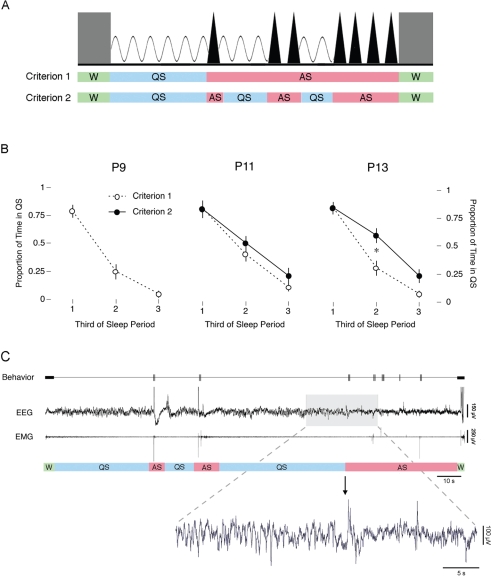Figure 3.
(A) Schematic of 2 alternative criteria used to define behavioral states (W: wakefulness; QS: quiet sleep; AS: active sleep). Grey blocks represent periods of W, sinussoidal waves represent delta activity, and triangles represent AS-related bursts of phasic activity. In Criterion 1, behavioral states were identified using nuchal electromyogram (EMG) and behavioral criteria. QS periods were defined as the time from the onset of atonia to the first myoclonic twitch, and AS periods were defined as the time from the first twitch to the onset of high muscle tone (regardless of the occurrence of interposed periods of behavioral quiescence). In Criterion 2, behavioral states were identified using electroencephalogram (EEG), EMG, and behavioral data. This criterion allowed for the occurrence of QS bouts interposed between AS bouts when positive evidence of delta activity was found. (B) Mean proportion of time spent in QS during each third of a sleep period. QS periods were identified using Criterion 1 (open circles) or Criterion 2 (filled circles). *Significant difference between 2 criteria. Mean ± SEM. (C) Top: Representative data from a subject on postnatal day 11 depicting a single sleep period comprising multiple QS and AS bouts. The top trace depicts behaviorally scored coordinated movements (thick horizontal bars) and myoclonic twitches (vertical tics), the middle trace depicts neocortical EEG activity, and the bottom trace depicts nuchal EMG activity. Behavioral states are identified beneath the EMG trace. The shaded region highlights the third QS bout of the sleep period as it transitions to the third AS bout. Bottom: EEG activity during the QS-AS transition highlighted above is depicted in expanded form. Before the transition to AS, bursts of 1- to 4-Hz delta activity can be seen. Once the transition to AS occurs, delta activity disappears.

